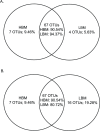A doubling of microphytobenthos biomass coincides with a tenfold increase in denitrifier and total bacterial abundances in intertidal sediments of a temperate estuary
- PMID: 25961719
- PMCID: PMC4427305
- DOI: 10.1371/journal.pone.0126583
A doubling of microphytobenthos biomass coincides with a tenfold increase in denitrifier and total bacterial abundances in intertidal sediments of a temperate estuary
Abstract
Surface sediments are important systems for the removal of anthropogenically derived inorganic nitrogen in estuaries. They are often characterized by the presence of a microphytobenthos (MPB) biofilm, which can impact bacterial communities in underlying sediments for example by secretion of extracellular polymeric substances (EPS) and competition for nutrients (including nitrogen). Pyrosequencing and qPCR was performed on two intertidal surface sediments of the Westerschelde estuary characterized by a two-fold difference in MPB biomass but no difference in MPB composition. Doubling of MPB biomass was accompanied by a disproportionately (ten-fold) increase in total bacterial abundances while, unexpectedly, no difference in general community structure was observed, despite significantly lower bacterial richness and distinct community membership, mostly for non-abundant taxa. Denitrifier abundances corresponded likewise while community structure, both for nirS and nirK denitrifiers, remained unchanged, suggesting that competition with diatoms for nitrate is negligible at concentrations in the investigated sediments (appr. 1 mg/l NO3-). This study indicates that MPB biomass increase has a general, significantly positive effect on total bacterial and denitrifier abundances, with stimulation or inhibition of specific bacterial groups that however do not result in a re-structured community.
Conflict of interest statement
Figures




References
-
- Vitousek PM, Aber JD, Howarth RW, Likens GE, Matson PA, Schindler DW, et al. Human alteration of the global nitrogen cycle: Sources and consequences. Ecological Applications. 1997;7(3):737–50. 10.2307/2269431 . - DOI
-
- Paerl HW, Valdes LM, Peierls BL, Adolf JE, Harding LW. Anthropogenic and climatic influences on the eutrophication of large estuarine ecosystems. Limnology and Oceanography. 2006;51(1):448–62. .
Publication types
MeSH terms
LinkOut - more resources
Full Text Sources
Other Literature Sources

